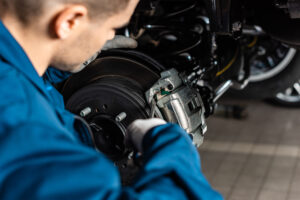Click or Press enter to Enter to Enable skip content option
Please Select a Section to Skip to

As you navigate the bustling streets of Ontario, California, or meander through the scenic routes of the Inland Empire, your car’s braking system plays a pivotal role in ensuring a safe journey. Whether you’re car shopping for a new or used vehicle, or diligently maintaining your current ride, understanding the importance of brake maintenance, particularly brake bleeding, is crucial. This comprehensive guide will help you recognize when and how often to bleed your car brakes, an essential part of your winter car care checklist.
Brake bleeding is the process of removing air bubbles from the brake fluid in your vehicle’s braking system. Air in the brake lines can lead to a spongy brake pedal feel and decreased braking efficiency, which are the last things you want, especially during Ontario’s winter months.
When to Bleed Your Brakes
As a rule of thumb, bleeding your brakes every 1-2 years is recommended. However, this can vary based on your driving habits and road conditions. At Ontario Auto Center we are here to help. Contact your dealership for more information and tips pertaining to your individual vehicle.
While DIY is an option, seeking professional brake service ensures precision and safety. For residents in Ontario, California, or the Inland Empire area, scheduling a service with our reputable service center is just a click away.
While great effort is made to ensure the accuracy of the information on this site, errors can occur. Please verify all pricing information with a customer service representative. This is easily done by calling us or visiting us at the dealership.
Customer may not qualify for ALL Rebates shown. Some rebates are stackable and others can and cannot be combined. See Dealer For Complete Details.